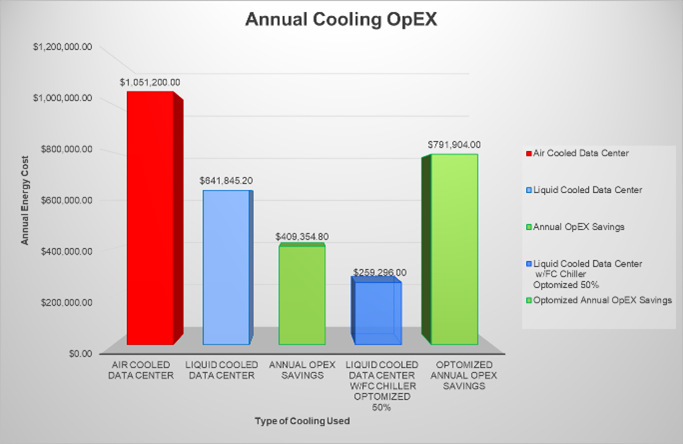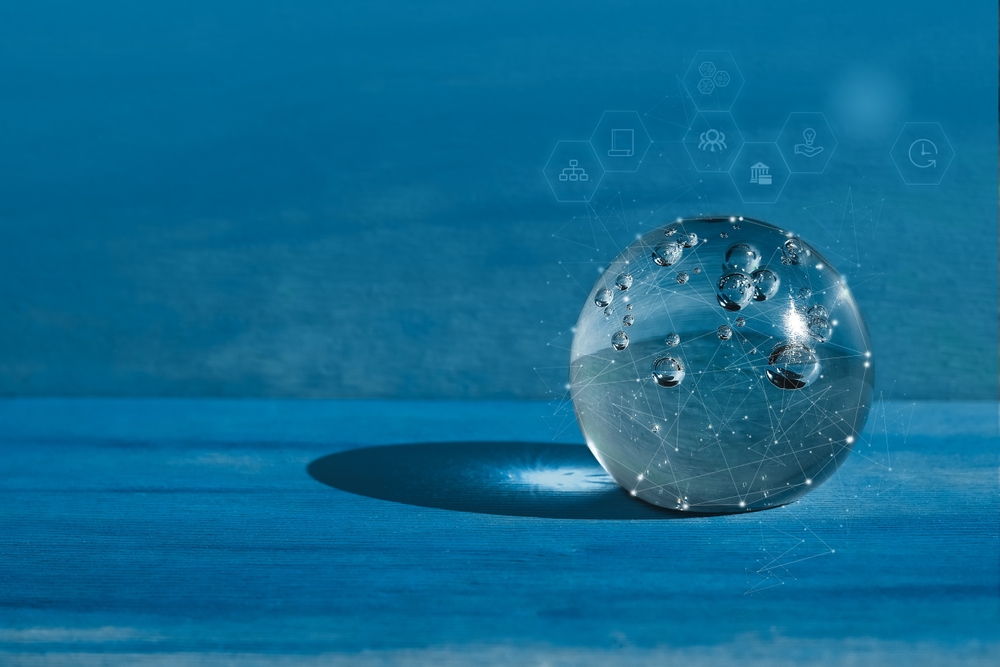The age of air cooling for data centers is rapidly coming to an end.
Advanced artificial intelligence (AI) and machine learning (ML) applications require incredible compute power to train and operate, and this has led hyperscalers, social media giants, and other data center customers to embrace increasingly powerful processors that require large amounts of power and produce a tremendous amount of heat.
As the average rack power density and heat produced within the data center envelope increases, liquid cooling becomes the only viable solution. The thermal conductivity of water is .58 Watts per meter kelvin (W/mk), while the thermal conductivity of air is .024 W/mk. This means water transfers heat approximately 24 times faster than air, making it a better and more effective alternative for cooling modern AI data centers.
This is why we’re increasingly seeing data center owners and operators – including colocation providers – looking to integrate liquid cooling into their data center designs for the future. This is also why data center owners are reaching out to us looking to retrofit existing data centers with liquid cooling systems.
Hyperscalers, social media giants, and other large technology companies want to partner with data center providers who are committed to sustainability.
But it’s not just about meeting the cooling requirements of today’s advanced AI solutions. There are other reasons why liquid cooling is the smarter alternative for data centers in 2024 and beyond.
Making strides towards “net zero”
The data center industry uses a tremendous amount of energy – only a portion of which is generated from renewable sources, depending on the market. This energy is used to power both the equipment in the envelope and the mechanical systems that keep the data center running.
Data centers often burn diesel fuel for backup power generation. They also utilize carbon-emitting heavy equipment and modes of transportation when building and outfitting their facilities.
There is tremendous pressure on enterprises across all industries to become more sustainable. This is especially true for industries such as data centers, transportation, construction, and others that are considered major contributors to global greenhouse gas emissions.
Liquid cooling can enable higher chilled water, supply air, and secondary inlet temperatures maximizing the efficiency of facility infrastructure.
Hyperscalers, social media giants, and other large technology companies want to partner with data center providers who are committed to sustainability. This has led to many colocation providers embracing aggressive carbon neutrality and sustainability goals and programs designed to mitigate their environmental impact.
Every major colocation provider and data center company has a page or section on their Website dedicated to their sustainability initiatives where curious individuals can see the progress they’ve made – or plan to make – towards becoming carbon neutral. Some large colocation providers, such as Equinix, CyrusOne, and Vantage Data Centers, have even set goals to be carbon neutral by 2030 –which is just six years away!
Thankfully, the same liquid cooling systems they’re embracing in their data centers to meet increased cooling requirements from AI can help them progress toward their sustainability goals.
Liquid cooling makes everything more efficient
A team of specialists from NVIDIA and Vertiv recently measured the impact of liquid cooling on the power usage of data centers. The two companies combined to analyze the performance of a data center that utilized four different liquid and air cooling combinations.
The first study utilized 100 percent air cooling. The second utilized air cooling for 61.4 percent of the load and liquid cooling for 38.6 percent. The third utilized liquid cooling for 68.6 percent of the load, with 31.4 percent cooled by air. And the final study had 74.9 percent of the load cooled by liquid, with just 25.1 percent cooled by air.
The study results were eventually published late last year by the American Society of Mechanical Engineers, and they were pretty eye-opening.
Here are two of the findings of the study that really stood out:
- The introduction of liquid cooling created a 10.2 percent reduction in total data center power and a more than 15 percent improvement in Total Usage Effectiveness (TUE). And was able to obtain a 27% reduction in facility power usage.
- Liquid cooling can enable higher chilled water, supply air, and secondary inlet temperatures maximizing the efficiency of facility infrastructure.
Ultimately, the study found that liquid cooling was more energy efficient than air cooling and that the introduction of liquid cooling made other equipment – both inside and outside of the envelope – more efficient.
Data centers, by their nature, are going to find it challenging to reach zero carbon emissions. They’ll need to run entirely on renewables, identify a clean alternative to diesel in backup generators, and take steps to mitigate the carbon emitted during equipment transportation and facility construction. But every small step that they can take to reduce their energy usage today will help them meet aggressive emissions goals in the future.
This study shows liquid cooling can accomplish that. But sustainability isn’t just about energy usage and carbon emissions.
Liquid cooling and water
While power usage and combatting carbon emissions are challenges that impact everyone around the globe, there are some areas where water conservation is just as important – and potentially more urgent. There has been no shortage of articles and news stories about the challenges facing many communities in the Southwestern United States, where lakes, rivers, and reservoirs are starting to dry up due to global climate change.

While some of the lakes and rivers with low water levels have rebounded since this summer, access to water is a challenge that many in this region have been facing for years – and many anticipate will be a problem in the future. In states like California and Arizona – two states with a large number of data centers that are operating or under construction – there is significant pressure to conserve water.
Many people in the data center industry might think that the introduction of liquid cooling replaces one sustainability challenge with another – reducing energy usage at the cost of increased water consumption. But that’s not the case.
The cooling towers used in some air cooling systems consume water to cool the air that will be circulated into the envelope. This water is evaporated and lost to the atmosphere around the unit. These cooling towers also require substantial upkeep and water treatment. This means that many existing air cooling systems not only require constant water replenishment, but also require the treatment of water with chemicals and additives designed to mitigate bio growth.
We can effectively eliminate this wasteful water usage by switching to a closed loop liquid cooling solution that incorporates a closed loop chiller or free-cooling chiller. The closed loop requires less upkeep, and the fluid does not need to be continually added. It simply continues to circulate for years – if properly maintained.
Liquid cooling is not just the most viable solution for today’s modern AI data centers. It can also help data centers make progress toward their carbon neutrality goals and reduce their water consumption. And that is massively impactful in places like the Southwestern United States, where water is in short supply.
